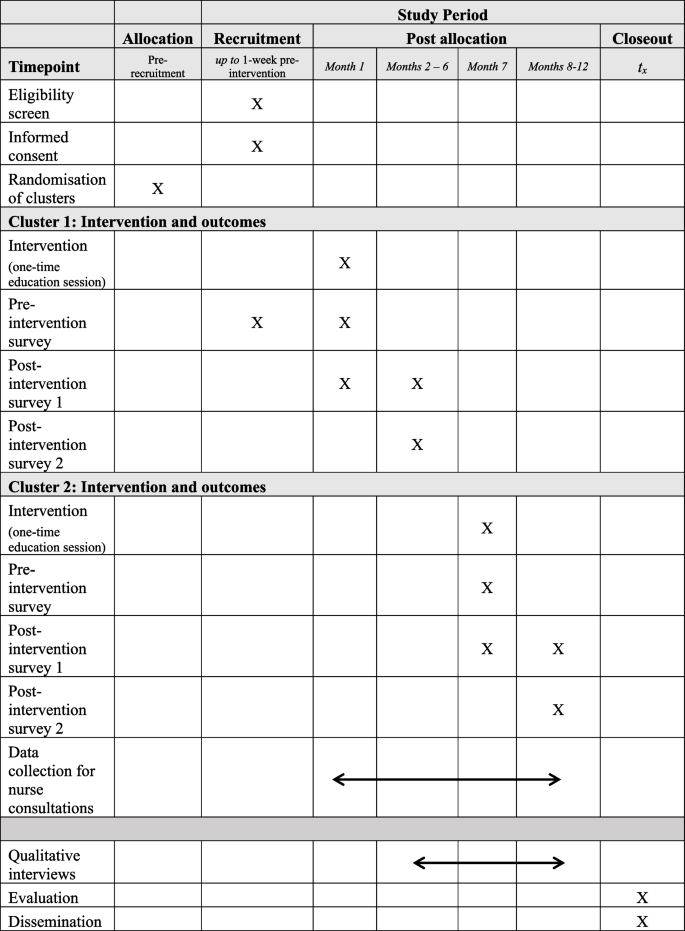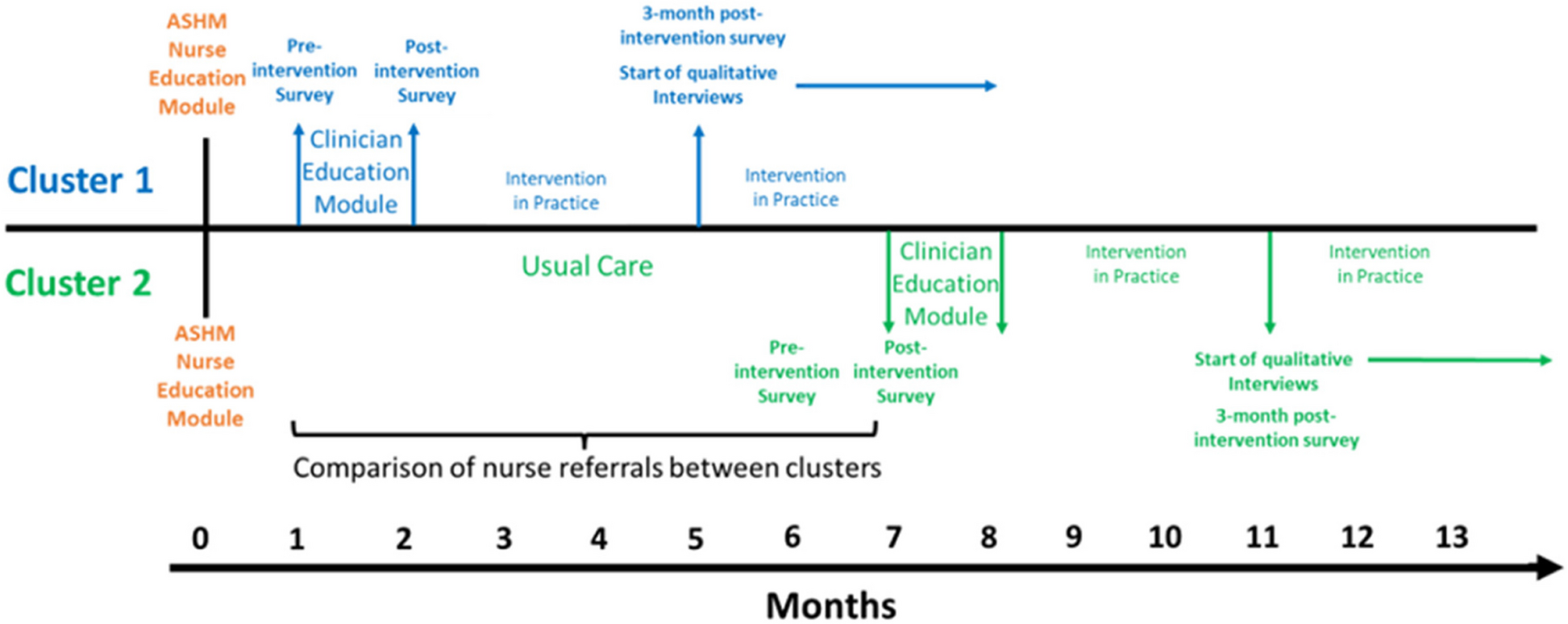Explanation for the choice of comparators {6b}
The comparator for the current study is sites where the educational intervention has not been provided to staff.
Intervention description {11a}
The research team has developed a SRH education and training program (henceforth referred to as the “intervention”) for delivery to CYMHS clinical staff. The intervention is a single onsite education and training session of 90 min duration, delivered in person by senior study investigators with expertise in adolescent mental health care (JS) and sexual and reproductive health care (JD). Following several initial meetings among the study investigators, a dedicated half-day workshop was held to determine the structure and content of the intervention. The workshop included members of the study team and four external health professionals with expertise in child and adolescent SRH and psychiatry. The resulting intervention was structured around four key components: (1) the importance of having the conversation, (2) creating a safe environment, (3) raising sensitive questions, and (4) knowing when and how to refer for a nurse-led SRH consultation. Given the time constraints of the intervention, core topics focused on sexually transmitted infections (STIs), contraception and reproductive health, and medication side effects (e.g. sexual dysfunction). In addition to SRH topics, the intervention also includes training on mandatory reporting, which was identified during the workshop as a critical area to address. Full details of the intervention content are provided in the supplementary materials.
CYMHS nursing staff who will provide nurse-led SRH consultations attended a one-day workshop delivered by an external SRH education provider to receive further training on SRH care. They will receive ongoing supervision and support from the senior study team members and senior SRH nurses in CHQ. The study team will consult with experts in child and youth health, psychiatry and SRH to collaboratively develop the intervention, along with SRH screening guides and resources for both clinicians and nurses to complement the education and training programme.
Criteria for discontinuing or modifying allocated interventions {11b}
Not applicable: The intervention comprises a one-time education session for healthcare professionals. There are no foreseeable risks, harms or discomfort associated with participation that would require discontinuation or modification of the intervention.
Strategies to improve adherence to interventions {11c}
To improve adherence to the intervention, the education session is scheduled within normal business hours at a time that is pre-designated for staff meeting times or regular professional development.
Relevant concomitant care permitted or prohibited during the trial {11d}
Not applicable: Since this is an educational intervention, there are no restrictions on concomitant care or additional training participants may receive during the trial.
Provisions for post-trial care {30}
Not applicable: Since the intervention is a negligible risk educational session delivered to healthcare professionals, no specific post-trial care provisions are required.
Outcomes {12}
The primary outcome for the study is to compare the number of referrals and reasons for referral for nurse-led SRH consultations between intervention and control sites for six months following the educational intervention.
The secondary outcome is to measure the change in levels of CYMHS clinician’s knowledge, skills and confidence of SRH screening of adolescents before and after the educational intervention.
The third outcome is to assess the (clinician, adolescent and parent) acceptability of SRH and a nurse-led SRH consultation within CYMHS.
Participant timeline {13}
All CYMHS clinicians in the three sites where the intervention will be delivered (Cluster 1) and the three control sites (Cluster 2) will be invited to participate in the study using a purposive sampling approach through relevant CYMHS email distribution lists specific to clinical staff for each site. All clinicians will be able to receive the intervention for professional development purposes, irrespective of participation, prior to delivery of the one-time intervention (Fig. 1).
Staff who consent to participate in the study will be invited via email to complete the pre-intervention survey electronically via REDCap prior to receiving the intervention. Email invitations and reminders will be emailed out (twice) at 1 week and one business day prior to the delivery of the intervention. Staff will also be given an opportunity to complete the survey immediately prior to receiving the intervention using their own devices (e.g. laptop or mobile phone). Post-intervention survey invitations (at 1 week and three months post-intervention) will be distributed via the same staff email distribution list. A maximum of three reminders via email will be distributed for each of the post-intervention surveys. The schedule of enrolment, interventions, and assessments as per SPIRIT (Standard Protocol Items: Recommendations for Interventional Trials) guidelines is shown in Fig. 2.

SPIRIT figure for sexual and reproductive health cluster randomised controlled trial
This same methodology will be used to recruit staff to participate in qualitative interviews. Adolescent consumers and parents/caregivers of adolescent consumers will be informed about the study and invited to participate in a qualitative interview by their treating clinicians during their normal appointments at CYMHS community sites (initially for Cluster 1 and then for Cluster 2 following the delivery of the intervention). Nurses who deliver the SRH consultations will also be able to invite eligible adolescent consumers and parents/caregivers to participate in a qualitative interview.
The invite will be in the form of a study flyer that clinicians will provide to adolescent consumers and their parents/caregivers. The flyer will contain details of the study, contact information, and a QR code that will link participants to a participant information and consent form in REDCap through which eligibility criteria will be assessed and subsequent consent obtained for those who are eligible.
Sample size {14}
All CYMHS clinicians and nurses in Clusters 1 and 2, and Forensic CYMHS clinics will be invited to participate in the study using a purposive sampling approach through relevant CYMHS email distribution lists specific to clinical staff for each site. All clinicians will be able to receive the intervention for professional development purposes, irrespective of participation, prior to delivery of the one-time intervention (Fig. 1). As this is a pragmatic cluster randomised controlled trial which aimed to explore preliminary effectiveness, feasibility and acceptability of an educational intervention, a formal power calculation was not undertaken. In addition, the sample size was limited by the total number of clinicians available at the recruitment site. The information derived from the trial will be utilised to inform power calculations for future studies, assuming the intervention is feasible and acceptable and translates to an increase in young people with mental health problems receiving sexual and reproductive health care.
For qualitative interviews, data collection will end once a maximum of 20 participants per strata (20 staff, 20 adolescent CYMHS clients and 20 parents/caregivers of adolescent CYMHS clients) is reached, or when data saturation has been achieved, whichever comes first.
The primary study sample will include clinical staff who are employed with CHQ CYMHS community clinics and Forensics CYMHS. The service employs the full-time equivalent of 160 clinicians across a variety of disciplines (medical, nursing, psychology, social work, occupational therapy and speech therapy) who work at the seven sites participating in the study.
Clinicians from the above sample, adolescent consumers of the service and parents and caregivers of adolescent consumers will be invited to participate in a qualitative interview to assess the acceptability of SRH care in a child and adolescent mental health service.
Recruitment {15}
CYMHS clinicians will primarily be recruited through CYMHS community site team leaders, who will encourage participation and facilitate the distribution of emails within their teams for the participation of educational intervention, surveys and qualitative interviews. To recruit young people and their parents/caregivers for qualitative interviews, a study flyer will be displayed in the consultation room, providing key study information and encouraging participation. Additionally, clinicians may introduce the research study to potential participants during appointments.
